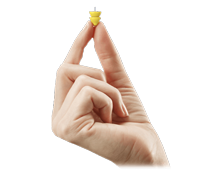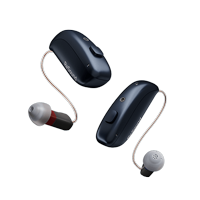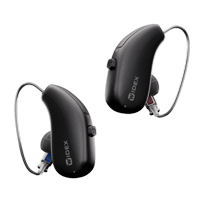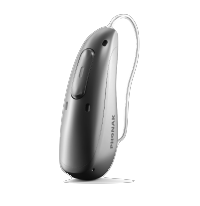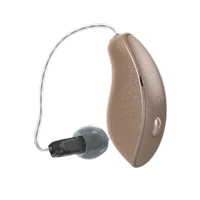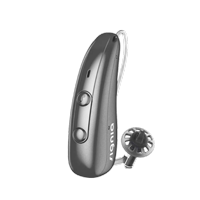When choosing a hearing aid, one of the first and most important decisions you’ll need to make is whether to select a style that fits inside your ear or one that sits behind your ear. Both options have their advantages and limitations, and the “better” choice depends on your specific hearing needs, lifestyle, preferences, and physical considerations.
Key Takeaway: Neither in-the-ear (ITE) nor behind-the-ear (BTE) hearing aids are inherently “better” than the other. As hearing experts point out, “No one style is ‘better’ than the other: It’s all about what works for you.” Your choice should be based on factors including the severity of your hearing loss, physical comfort, aesthetic preferences, feature requirements, and handling abilities.
Disclaimer
The information provided on this page is for general informational purposes only and is not intended as medical advice. Your specific hearing needs are unique, and the best hearing aid style for you should be determined in consultation with a qualified audiologist or hearing healthcare professional.
This information is current as of April 2025 but hearing aid technology continues to evolve rapidly.
Understanding the Two Main Hearing Aid Styles
Before comparing the advantages and limitations of each style, let’s clarify exactly what we mean by “in-the-ear” and “behind-the-ear” hearing aids, as there are several variations within each category.
In-the-ear hearing aids sit partially or completely within the ear canal or the outer portion of the ear. All components (microphone, amplifier, speaker, and battery) are housed in a single case that fits in or fills the ear.
These devices are custom-molded to fit the unique shape of your ear, though some newer over-the-counter options use standard sizing with different tips.
ITE hearing aids range from nearly invisible devices that sit deep in the ear canal to larger options that fill most of the outer ear bowl.
Behind-the-ear hearing aids have their main components housed in a case that sits behind or on top of the outer ear. Sound is delivered to the ear canal through either a thin tube or a wire with a small speaker (receiver) at the end.
Modern BTE hearing aids are much smaller and more discreet than older models. The most popular type today is the Receiver-in-Canal (RIC) design, which places the speaker directly in the ear canal connected by a thin wire.
BTE hearing aids range from mini-BTE designs that are barely visible to more powerful standard BTE models.
Types of In-The-Ear Hearing Aids
In-the-ear hearing aids come in several different sizes and styles, ranging from completely invisible to filling the entire outer ear. Here are the main types:
The smallest and least visible type that sits very deep in the ear canal. These are custom-fitted and nearly invisible when worn.
Sits deep in the ear canal but is slightly larger than IIC models. These are still very discreet but offer a bit more power and features.
Fits partially in the ear canal but extends slightly into the outer ear. These offer more features and easier handling than smaller models.
Fills the lower portion of the outer ear bowl. These offer more power and features while still being relatively discreet.
The largest ITE style, filling most of the ear bowl. These provide maximum power and features for an in-ear device and are easiest to handle.
Types of Behind-The-Ear Hearing Aids
Behind-the-ear hearing aids also come in several variations, primarily differentiated by size and how sound is delivered to the ear:
The most popular modern BTE style, with the main case behind the ear and a thin wire connecting to a speaker (receiver) placed in the ear canal. As experts note, “RIC (short for ‘receiver-in-canal’) hearing aids place a speaker at the end of the wire.”
A small BTE device with a thin tube that leads to an open-style earpiece. This allows natural sound to enter the ear alongside amplified sound.
The traditional, slightly larger BTE model with a tube leading to a custom earmold that fits in the ear canal. These offer maximum power for severe to profound hearing loss.
Pros and Cons of In-The-Ear Hearing Aids
When considering in-the-ear hearing aids, it’s important to weigh their advantages against their limitations:
- Aesthetic appeal: More discreet appearance, with some models being nearly invisible when worn
- Less noticeable: No visible components sitting behind the ear
- Wind noise reduction: Less susceptible to wind noise since microphones are protected inside the ear
- Phone compatibility: Often easier to use with telephones as the microphone is positioned where the phone naturally sits
- No interference with glasses or masks: Won’t compete for space with eyeglasses, face masks, or hats
- Natural sound localization: For some users, placement in the ear canal creates a more natural sound experience
- Easier insertion for some: Some people find ITE aids easier to insert than managing the behind-ear placement and wire/tube positioning of BTE models
- Limited power: Generally not suitable for severe or profound hearing loss due to size constraints
- Fewer features: Smaller models have limited space for advanced features like directional microphones or Bluetooth
- Shorter battery life: Smaller size means smaller batteries and more frequent changes/charging
- Maintenance challenges: More susceptible to damage from earwax and moisture
- Difficulty with handling: Smaller sizes can be challenging for those with dexterity issues
- Occlusion effect: Can create a “plugged up” feeling and affect how your own voice sounds
- Feedback issues: May be more prone to whistling in some users
- More frequent repairs: Generally require more maintenance due to exposure to ear canal conditions
Pros and Cons of Behind-The-Ear Hearing Aids
Behind-the-ear models have their own set of advantages and limitations to consider:
- Greater power: Can accommodate more powerful amplification for all degrees of hearing loss
- More features: Larger size allows for more advanced technology and features
- Better connectivity: More space for Bluetooth and wireless connectivity options
- Longer battery life: Larger batteries last longer between changes/charges
- Easier handling: Larger size makes them easier to insert, remove, and adjust
- Durability: Main components are protected from moisture and earwax, making them “easier to clean and maintain.”
- Easier maintenance: Components can be cleaned without specialized tools
- More fitting options: Can be fit with various dome sizes or custom earmolds
- Visibility: More noticeable than in-canal options, though modern designs are much more discreet than older models
- Wind noise: More susceptible to “issues with wind noise when using their hearing aid in open spaces.”
- Potential for discomfort: May cause friction or pressure points behind the ear
- Glasses interference: Can compete for space with eyeglasses, face masks, or hats
- Learning curve: Proper insertion of tubes or wires may take practice
- Potential loss of sound quality: Sound may be slightly altered as it travels through tubing (primarily in standard BTE models)
RIC: A Popular Middle Ground
Receiver-in-Canal (RIC) hearing aids have become extremely popular because they offer a middle ground between traditional BTE and ITE styles. With the main housing behind the ear and just a tiny speaker in the ear canal, they combine many of the advantages of both approaches. They’re more powerful and feature-rich than most ITE models but more discreet and comfortable than traditional BTE styles.
Who Might Benefit from Each Style?
While individual needs vary greatly, certain hearing aid styles tend to work better for specific situations and users:
- People with mild to moderate hearing loss who don’t need maximum power
- Those concerned about visibility and wanting the most discreet option
- Active phone users who make frequent calls without Bluetooth
- Eyeglasses wearers who experience discomfort with devices behind the ear
- People who regularly wear hats, helmets, or masks that might interfere with BTE devices
- Those who experience significant wind noise with BTE models
- People with severe to profound hearing loss who need powerful amplification
- Those with dexterity issues who have trouble handling small devices
- Users who want advanced features like Bluetooth streaming and rechargeability
- People who produce excess earwax or have ear canals prone to moisture
- Those who experience the occlusion effect with in-ear devices (though open-fit BTE models)
- Children whose ear canals are still growing and need frequent adjustments
Key Factors to Consider When Choosing
When deciding between in-the-ear and behind-the-ear hearing aids, consider these important factors:
| Factor | Considerations |
|---|---|
| Severity of Hearing Loss |
|
| Dexterity and Handling |
|
| Lifestyle and Activities |
|
| Anatomical Factors |
|
| Desired Features |
|
| Budget |
|
“The best hearing aid is the one you’ll actually wear consistently. Aesthetic concerns, comfort, and usability should never be dismissed when making this important decision.”
— Common wisdom among audiologists
Recent Innovations in Hearing Aid Design
The distinctions between in-the-ear and behind-the-ear hearing aids continue to evolve as technology advances. Some recent innovations are blurring the traditional boundaries between styles:
- Smaller BTE/RIC devices: Modern behind-the-ear aids are dramatically smaller than previous generations
- More powerful ITE options: Advances in miniaturization have increased the power available in custom in-ear devices
- Better connectivity in smaller packages: Bluetooth and wireless features are becoming available in smaller ITE models
- Rechargeable ITE models: Previously limited to larger devices, rechargeability is now available in some smaller options
- Over-the-counter (OTC) options: New non-prescription hearing aids in both styles provide more consumer choice
Frequently Asked Questions
In-the-ear hearing aids, particularly IIC (Invisible-in-Canal) and CIC (Completely-in-Canal) styles, are generally the most discreet options as they sit deep in the ear canal and are virtually invisible to others. However, modern BTE/RIC devices have become much smaller and less noticeable, often hiding behind the ear with only a thin, nearly invisible wire visible. For many people, today’s mini RIC devices are discreet enough while offering better performance and features than the smallest in-ear options.
Sound quality is determined more by the technology level, sound processing capabilities, and proper fitting than by the style itself. However, the placement can affect how sound is perceived:
- ITE aids may provide more natural sound localization due to their placement in the ear
- BTE/RIC aids often have space for more advanced sound processing technology
- Open-fit BTE/RIC models allow natural low-frequency sounds to enter the ear alongside amplified high frequencies, creating a more natural sound for those with good low-frequency hearing
Your audiologist can help you compare the sound quality of different options during your fitting process.
Yes, in-the-ear hearing aids generally have higher repair rates and shorter lifespans than behind-the-ear models. This is primarily because their location inside the ear canal exposes them to more moisture, earwax, and debris. The electronic components in BTE hearing aids are housed in a case behind the ear, protecting them from these elements. However, proper maintenance and regular cleaning can significantly extend the life of ITE hearing aids.
It depends on how you use your phone:
- For traditional phone calls without Bluetooth: ITE aids often work better as the phone can be held naturally against the ear without causing feedback
- For Bluetooth streaming: BTE/RIC models typically offer more robust wireless connectivity options for direct streaming from smartphones and other devices
Many modern hearing aids in both styles now offer smartphone app control for adjusting settings and creating custom programs.
Yes, you can switch hearing aid styles if your first choice doesn’t work well for you. Most hearing aid providers and manufacturers offer trial periods (typically 30-60 days) during which you can return or exchange your hearing aids if you’re not satisfied. Keep in mind that custom-molded ITE devices are made specifically for your ear, so they typically cannot be returned for a full refund but may be exchanged for a different style with some adjustment to the price.
If you’re uncertain about which style would work best for you, consider discussing a trial of each type with your audiologist before making a final decision.
The COVID-19 pandemic highlighted a challenge for hearing aid wearers: mask straps can interfere with hearing aids. In general:
- ITE hearing aids have an advantage with masks as they sit entirely within the ear and don’t compete for space with mask straps
- BTE/RIC devices may be dislodged when removing masks if the straps catch on the portion behind the ear
- Special “mask extenders” or “ear savers” that connect mask straps behind the head rather than over the ears can help BTE wearers avoid this problem
If you regularly wear masks and prefer a BTE style, discuss solutions with your hearing healthcare provider.
Making Your Decision: A Step-by-Step Approach
Choosing between in-the-ear and behind-the-ear hearing aids is a personal decision that should be made with professional guidance. Consider this approach:
- Get a comprehensive hearing evaluation from a qualified audiologist to determine the type and degree of your hearing loss
- Discuss your lifestyle, preferences, and concerns with your hearing healthcare provider
- Try on demonstration models of different styles to assess comfort and appearance
- Consider arranging a trial period with your preferred style before making a final purchase
- Be open to recommendations from your audiologist based on your specific hearing needs
A Hybrid Approach
Some people benefit from having different hearing aid styles for different situations. For example, you might use more powerful BTE devices for everyday use and smaller ITE devices for special occasions where discretion is paramount. Discuss with your audiologist if this might be an appropriate option for your needs.
Conclusion: Finding Your Perfect Fit
The question “Are hearing aids better in the ear or behind the ear?” doesn’t have a one-size-fits-all answer. The best hearing aid style for you depends on your unique combination of hearing needs, lifestyle, preferences, and physical characteristics.
While behind-the-ear hearing aids dominate the market due to their versatility, power, and feature set, in-the-ear models offer significant advantages for many users, particularly those concerned with discretion or comfort with glasses and masks.
The most important factors in successful hearing aid use are proper fitting, appropriate technology for your specific hearing loss, and consistent wear. Work closely with a qualified hearing healthcare professional to find the solution that will best help you hear the sounds that matter in your life.
Turning Life up Through Better Hearing
For over 30 years, California Hearing Center has been helping people improve their lives through better hearing. Our experienced audiologists can help you compare different hearing aid styles and find the perfect solution for your unique needs.
Or call us at (650) 342-9449
Keywords: in the ear vs behind the ear hearing aids, ITE hearing aids, BTE hearing aids, hearing aid styles comparison, best hearing aid style, hearing aid pros and cons, invisible hearing aids, receiver in canal hearing aids, hearing aid comfort, discreet hearing aids


